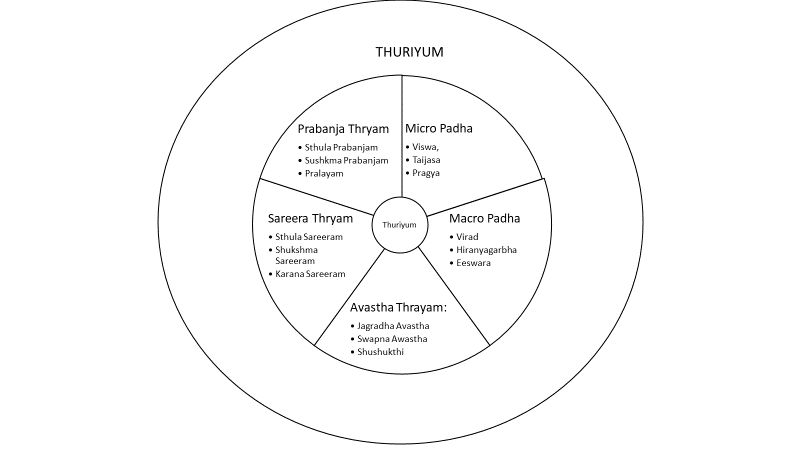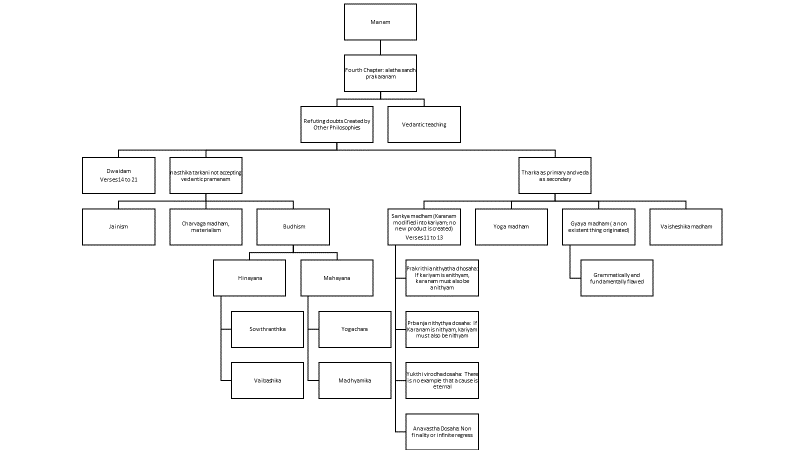Mandukya Upanishad, Class 51
The essential teachings of Mandukya
Upanishad are:
- Brahma Sathyam: Highlighted in 3rd chapter Advaida
Prakaranam. - Jagan mithya is established in the second chapter
Vaithathya prakaranam; Two layers of swapna pranajanja and jagradha
prabanaja are dwaidam and put together they are called as jagat. We
generally accept swapna as mithya; but some philosophers conclude swapna
as sathyam and many people claim jagrath is sathyam. - Who am I? Do I come under sathyam category or
mithya category? The question is what you mean by the word I.
If it is sthula sareeram, shuksma sareeram or karana sareeram then you are
mithya. If you say I am not those three, but I am the sakshi
chaithanyam, then you will be sathyam brahman. Learn to identify
with chaithanyam and claim aham brahma asmi. In me the advaida
chaithanyam the mithya jagrath dwaidam and swapna dwaidam is
floating. Let them continue but know you are ever free.

If you assimilate the teachings from
the three chapters, then you are ever free. The first three chapters give
the basic three concepts. If you are able to receive the teaching
clearly, with that sravanam, then you get gyanam. But for many teachers,
the intellect will not be convinced by this teaching, because the intellect
raises many doubts regarding brahma sathyam, jiva mithya. Some people
doubt brahma sathyam; some doubt jagath mihtya; some doubt aham brahma; and
others doubt all three. Unobstructed knowledge alone give
liberation. Obstruction for knowledge is always doubt. The
process prescribed for removing all the doubts is mananm. First three
chapters are sravana pradhana chapters. In the third chapter, towards the
end nidhithyasanam was discussed. The fourth chapter concentrates mananam
part of vedantic study. When all the possible doubts are eliminated the
knowledge will be clear. The doubts regarding vedanta can be generated by
many intellects. The doubt can be created by my own mind or by some one
else. Many systems of philosophies criticize advaidam for logical
loopholes. As a sample, we take some of the other systems of philosophy
and answer those questions. Dharsanam means systems of philosophies and
they can be broadly classified into two:
- Logic based philosophy; tharka based philosophy wherein
they rely up on logic and attack advaidam. These group of
philosophies do not accept veda pramanam. They are called nasthika
tarkani not accepting vedantic pramanam; they are six- Jainism by Rishaba Deva in Baghavadham and Marthavana
Mahavira is the activator. - Charvaga madham, materialism
- Four branches of budhism
- Jainism by Rishaba Deva in Baghavadham and Marthavana
- Tarka dominant philosphy; logic dominant
philosophy. This groups accepts veda pramanam but they consider
tharka as primary and veda as secondary. They adjust veda to suit
tarka. They are four in number:- Sankya madham: by Kapila muni
- Yoga madham: Patanajali Muni
- Gyaya madham: Gowdhama Muni
- Vaisheshika madham: Kanadha Muni
We face the challenge in two ways:
- Defensive approach: defend the vedanta; Vedanta has nothing to do with logic. Therefore, you should not use logic to prove or disprove vedanta; the very attempt shows lack of knowledge of vedanta; the knowledge given by one sense organ (e.g eye) can’t be disproved by another sense organ (e.g ear). If you have doubt regarding the color, again you use your eyes and recheck. If the light is not sufficient, add extra light; change the power of glass; ultimately the color has to be reconfimed with eye only. Tharka functions in one field and vedanta functions in another field; Vedanta is neither logical or illogical; it is trans logical; The instrument you use is improper. It is like using the tape measure to use weight.
- Offensive approach by pointing out the logical deficiency in their philosophies. We take the approach that all the ten conclusions is full of logical loophole. Keeping a logical dharahsanam, you have no right to question me. Logic can’t arrive at truth. Use tarka or logic as subservient to vedanta.
There are 100 verses in the fourth chapter.
First half of fourth chapter is dedicated to refute the ten dharshams; the
later half is dedicated to remind vedantic teaching. This title is called
alatha sandhi prakaranam. Alatha means a stick with fire at one
end. Like our present-day torch.

Verse 1
In the first two verses Gowdapadha
offers prayer to ward off all the obstacle. The first verse is namaskara
offered to aadhi guru, Narayana. In the second verse, he offers namaskara
to the very teaching itself. We revere the teaching as goddess
Saraswathi.
Since we offer prayer to the lord as
aadhi guru, he has self knowledge or jivatma pramatma aikya gyanam. When
an ordinary jiva has aikya gyanam, he knows I the jivatma is non different from
paramatma. When Lord gains knowledge, I the paramatma am non
different from Jivatma. I worship that paramtma who has the knowledge
that he is not different from jiva. The uniqueness of this knowledge is
that it is a knowledge in which the subject, object and the instrument are one
and the same. In self knowledge, consciousness knows consciousness.
The subject, object and instrument are all consciousness because through
consciousness alone you know any and everything. The paramtma
consciousness knows the jivatma consciousness with the help of consciousness.
This is division less consciousnesses there is no subject, object division.
I worship that Narayana who has that
aikya knowldge in whcih subject, object and instrument is not there